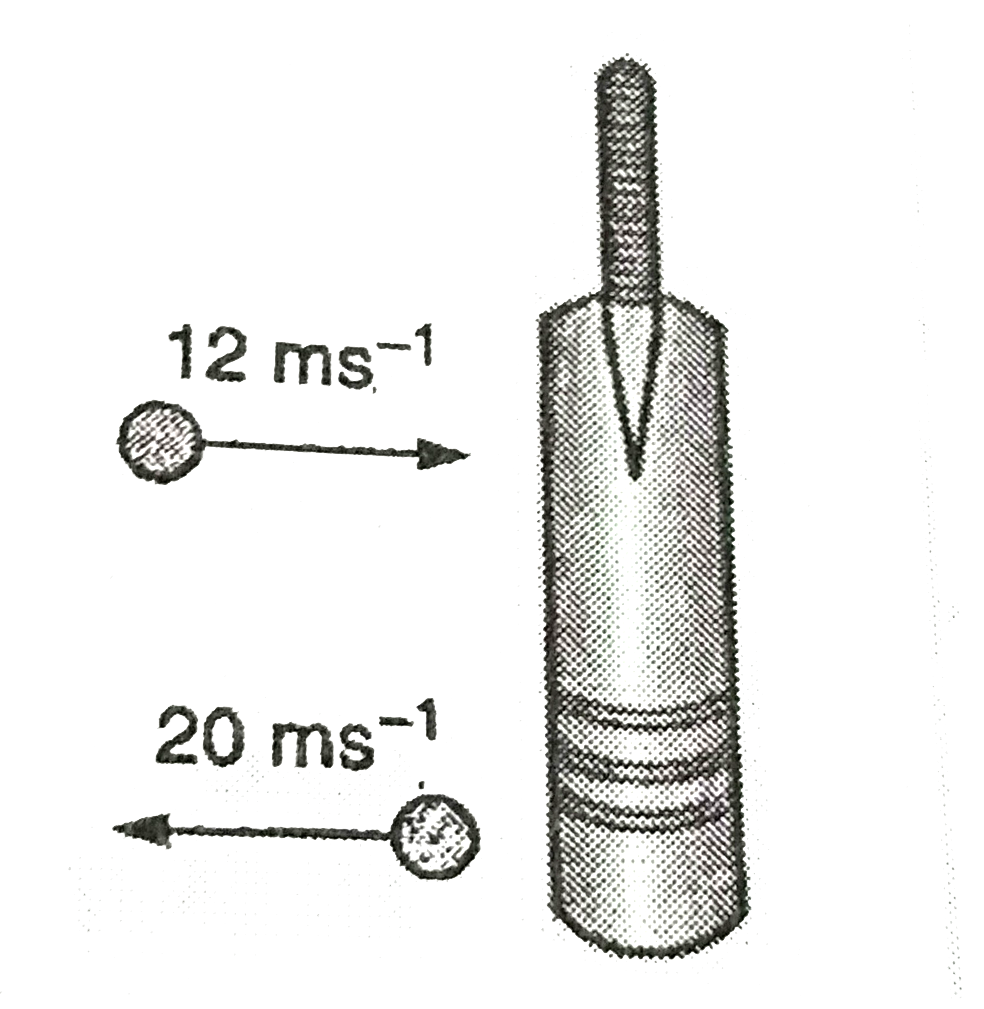A cricket ball of mass 150 g is moving with a speed of 12ms−1 and is hit by a bat so that the ball is turned back with velocity of 20ms−1 if duration of contact between bat and ball is 0.01 s then:

120N
280N
380N
480N
The correct Answer is:D
According to given question, change in momentum of the ball
Δp=pf−pi=m(v−u)=15×10−3[20−(−12)]
So, by impulse- momentum theorem, impulse I=Δp=4.8Ns
And by time averaged definition of force in case of impulse
Fav=IΔt=ΔpΔt=4.800.01=480N
Topper's Solved these Questions
- BOOK - DC PANDEYCHAPTER - LAWS OF MOTIONEXERCISE - Check point 5.120videos
LAWS OF MOTION
- BOOK - DC PANDEYCHAPTER - LAWS OF MOTIONEXERCISE - Check point 5.215videos
LAWS OF MOTION
- BOOK - DC PANDEYCHAPTER - LAWS OF MOTIONEXERCISE - Subjective Question27videos
LAWS OF MOTION
- BOOK - DC PANDEYCHAPTER - KINEMATICS 1EXERCISE - INTEGER_TYPE15videos
KINEMATICS 1
- BOOK - DC PANDEYCHAPTER - LAWS OF THERMODYNAMICSEXERCISE - Level 2 Subjective18videos
LAWS OF THERMODYNAMICS
Similar Questions
cricket ball of mass 150 g is moving with a velocity of 12m/sec and is hit by a bat so that the ball is turned back with a velocity of 20m/sec, the force on the ball acts for 0.01 sec, then the average force exerted by the bat on the ball will b
View SolutionA cricket ball of mass 150 kg is moving with a velocity of 12m/s and is hit by a bat so that ball is turned back with a velocity of 20m/s . The force of the blow acts for 0.01 s on the ball . Find the average force exerted by the bat on the ball.
View Solution
Knowledge Check
- Question 1 - Select One
According to Newton s second law of motion F=ma where F is the force required to produce an acceleration a in a body of mass m If a = 0 then F=0 no external force is required to move a body uniformly along a straight line If a force F acts on a body for t seconds the effect of the force is given by Impulse =F × t = change in linear momentum of the body
A cricket ball of mass 150g is moving with a velocity of 12m/s and is hit by a bat so that the ball is turned back with a velocity of 20m/s if duration of contact between the ball and the bat is 0.01sec The impulse of the force is .A7.4N−sB4.8N−sC1.2N−sD4.7N−s - Question 2 - Select One
A cricket ball of mass 150g is moving with a velocity of 12 m/s and is hit by a bat so that the ball is turned back with a velocity ishit by a bat so that the ball is turned back with a velocity of 20 m/s. The force of blow acts for 0.01 s on the ball. What is the averate force exerted by the bat on the ball?
A240NB300NC380ND480N - Question 3 - Select One
A cricket ball of 0.5 kg is moving with a velocity of 100ms−1. The wavelength associated with its motion is :
A1/100cmB65×10−34mC1.32×10−35mD6.6×10−28m
6A cricket ball of mass 250 gm moving with a velocity of 24 m/s is hit by a bat so that it acquires a velocity of 28 m/s in the opposite direction. The force acting on the ball, if the contact time is 1/100 of a second, will be -
View SolutionA ball of mass 10g is initially moving with a velocity of 50ms−1 On applying a constant force a ball for 2.0s, it acquires a velocity of 70ms−1 calculate
the initial momentum of ballView SolutionA ball of mass 10g is initially moving with a velocity of 50ms−1 On applying a constant force a ball for 2.0s, it acquires a velocity of 70ms−1 calculate
the final momentum of ballView SolutionA ball of mass 0.5 kg moving with a velocity of 2ms−1 strikes a wall normally and bounces back with the same speed. If the time of contact between the ball and the wall is one millisecond, the average force exerted by the wall on the ball is
View SolutionA cricketer catches a ball of mass 150 gm. in 0.1 second moving with speed 20ms–1. Then he experiences force of : -
View Solution

